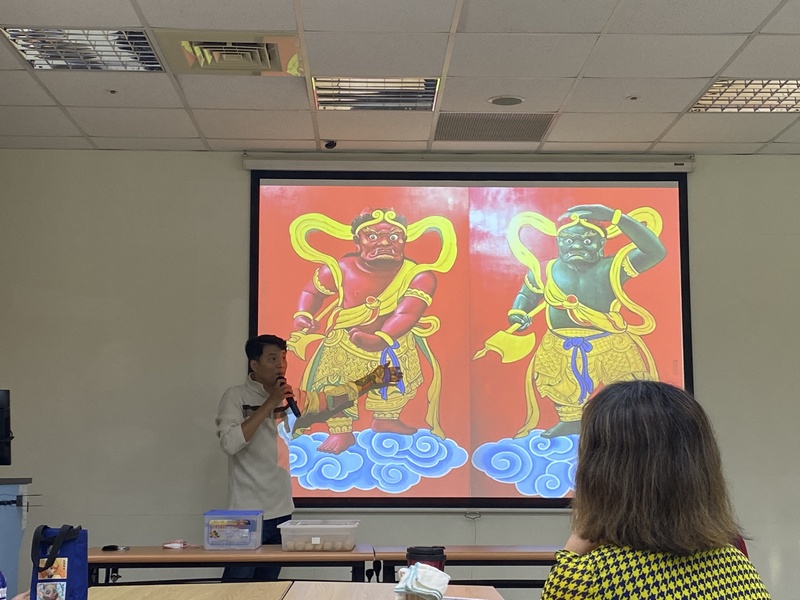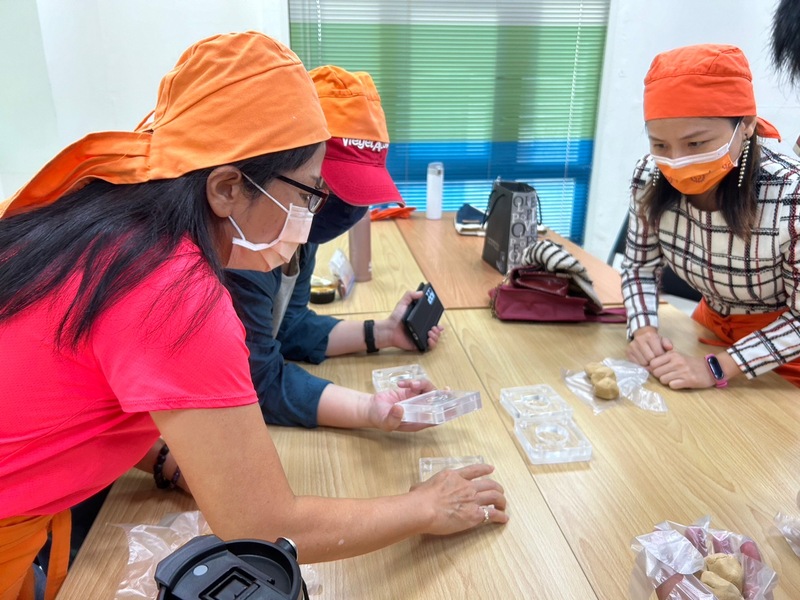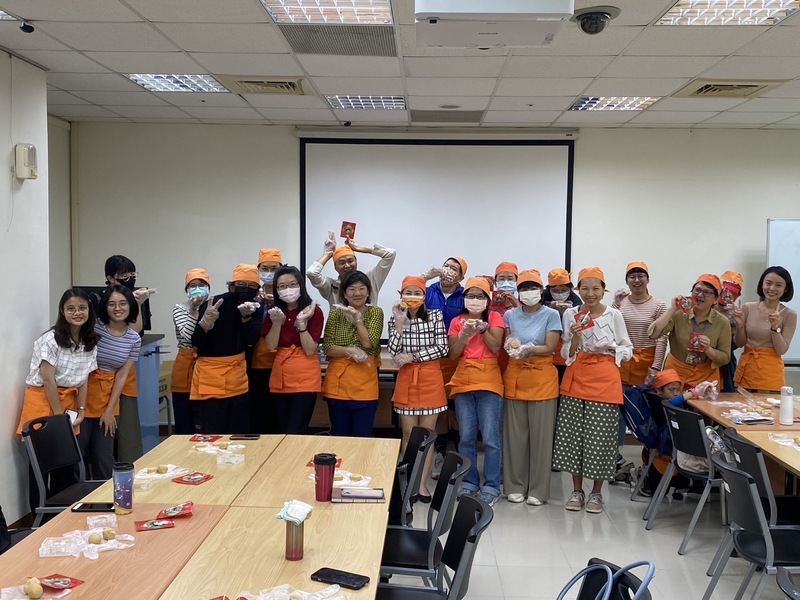【計畫團隊學生|林亭妤報導】
文藻外語大學社會責任實踐計畫─「OUR TOWN 社區永續跨域共創平台計畫」,於本學期開設多類共創社群,其中「文化體驗設計社群」團隊,有幸與舊城文化協會合作,邀請陳振榮經歷蒞臨文藻,為大家講述門神的各式種類及祂們各自與廟宇的關係為何,以此認識傳統門神文化,也透過手作門神綠豆餅,在體驗中,以此帶領學員們對於「門神」的概念、象徵意義有更加深刻的印象與充分的認知。
Wenzao Ursuline University of Languages' University Social Responsibility Practice Program, "OUR TOWN Community Sustainable Cross-Domain Collaborative Platform Project”has initiated various collaborative communities this semester. Among them, the "Cultural Experience Design Community" had the privilege of collaborating with Kaohsiung Cultural Association. They invited Manager Chen Zhenrong to share his experiences and insights on various types of gate gods and their respective relationships with temples, thus acquainting everyone with traditional door god culture. Through the handicraft activity of making the Gate God Mung Bean Cake, participants were led to gain a deeper and more comprehensive understanding of the concept and symbolic significance of "gate gods" through direct experience.
本學年的系列活動已到達了尾聲,最後一場交由陳振榮經理為大家講述生動有趣且富含文史養分的故事-舊城門神。陳經理說明位於左營舊城的北門,其上方門神雕塑的由來,是由於在清朝年間所發生的林爽文事件。當時人們對於動亂深感懼怕,因此決定遷城從興隆莊(今左營)到下埤頭(今鳳山),但後來又收到聖旨請居民搬回興隆莊,許多人不願意之下,就編造有知縣在新城蓋好後就身亡的謠言,以塑造左營舊城為風水不好的地點,成為繼續居住在鳳山的藉口。爾後,為了讓人們可以安心遷回舊城,官員便決定在北門上雕刻門神,象徵有「守護」、「震煞」及「驅邪」的作用。這即是在左營當地,口耳相傳的門神故事。陳經理藉此故事,讓許多參與學員理解到原來我們看似平凡無奇的門神雕塑藝術,事實上背後攸關的是在當地曾經發生過的真實歷史事件。
The series of activities for this academic year has come to a close, with the final session led by Manager Chen Zhenrong, who shared lively and historically rich stories about the old town gate gods. Manager Chen explained the origin of the gate god sculptures above the North Gate of the old town in Zuoying. It stemmed from the “Lin Shuangwen event” during the Qing Dynasty. At that time, people were deeply afraid of the unrest, so they decided to move the town from Xinglong Village (now Zuoying) to Xiapitou (now Fengshan). However, later they received an imperial edict asking residents to move back to Xinglong Village. Many people were unwilling, so they fabricated rumors that a magistrate died after the completion of the new town, creating the notion that Zuoying's old town was an unfavorable location for Feng Shui, providing an excuse to continue living in Fengshan. Subsequently, to reassure people about returning to the old town, officials decided to carve gate god sculptures on the North Gate, symbolizing their function of "guarding," "suppressing evil," and "warding off demons." This is the locally circulated story of gate gods in Zuoying. Through this story, Manager Chen helped many participating students understand that behind the seemingly ordinary gate god sculptures lies a connection to real historical events that occurred in the area.
緊接著,陳經理繼續地為大家介紹關於門神的類別、各自背後的緣由與特色。例如自然現象也能被形象化,成為神祇。舉例來說,風神會手持芭蕉扇來扇風、雨神一手持楊柳枝,一手持缽,當楊柳枝沾上缽中的水,就可灑水變為雨水。此外,當我們看到關公與另一位形象斯文的白臉人物,便可推斷此廟為佛教的廟宇,因據說關公在三國演義中救過這位白臉和尚,後來關公因一些事件而頓悟,決定「放下屠刀立地成佛」,被後人稱作「伽藍菩薩」。而當看到千里眼與順風耳,便能判定是媽祖廟;七爺八爺則為城隍廟。從以上的敘述與判定,可以明白觀察門神的特色細節及背後故事,就可知曉廟宇的性質,甚至延伸到整個在地的歷史脈絡與文化體現。
Continuing on, Manager Chen proceeded to introduce the different categories of gate gods, along with the reasons and characteristics behind each. For instance, natural phenomena can also be anthropomorphized into deities. For example, the Wind God may carry a banana leaf fan to create wind, while the Rain God may hold a willow branch in one hand and a bowl in the other; when the willow branch touches the water in the bowl, it can sprinkle water, symbolizing rain. Additionally, when we see Guan Gong alongside another figure, typically a cultured white-faced character, we can infer that it is a Buddhist temple, as Guan Gong is said to have saved this white-faced monk in the Romance of the Three Kingdoms. Later, Guan Gong attained enlightenment after certain events and decided to "lay down the butcher's knife and become a Buddha on the spot," thus earning the title of "Garland Bodhisattva" by later generations. When observing Thousand-Mile Eyes and Favorable Wind Ears, one can determine that it is a temple dedicated to Mazu, while the QiYe and BaYe (Guarding Deities) are associated with Town God temples. From the descriptions and identifications above, one can understand the unique details and background stories of gate gods, thereby gaining insights into the nature of temples and even extending to the broader local historical context and cultural manifestations.
在手作方面,本次製作由綠豆糕為原料的糕餅-門神餅。在刻有「門神」與「城門」圖樣的模具中,將綠豆糕餅搓圓後並放入,脫模後便可以看到清晰且可愛的圖案了!如此具備簡易與美味的糕餅製作,參與學員們紛紛表示相當有趣也很有意義,主要是聆聽豐富的文史故事再搭配手作體驗,可以幫助他們對於自身的傳統文化更加親近,而不是生疏與陌生的距離感。期盼學員們能藉由此次體驗,對在地能有更多的關注,並為在地文化推廣付出心力。
In terms of hands-on activities, this session involved making gate god cakes using mung bean cake as the main ingredient. Using molds imprinted with patterns of "gate gods" and "town gates," participants rolled the mung bean cake mixture into balls and placed them into the molds. After demolding, clear and adorable patterns could be seen! Such simple and delicious cake-making activities were found to be both enjoyable and meaningful by the participants. They particularly appreciated the opportunity to listen to rich cultural and historical stories while engaging in hands-on experiences. This combination helped them feel closer to their own traditional culture rather than feeling distant and unfamiliar. It is hoped that through this experience, the participants will develop a greater interest in local culture and contribute to its promotion and preservation.

舊城文化協會陳振榮經理講述門神種類與廟宇關係(林亭妤 攝影)
Manager Chen Zhenrong from Kaohsiung Cultural Association discusses the types of gate gods and their relationship with temples.

學員利用模具製作糕餅(林亭妤 攝影)
The participants use molds to make cakes and pastries.

手作親子同樂時間(林亭妤 攝影)
Handmade parent-child fun time

講師與參與學員及社群工作人員合影(林亭妤 攝影)
The lecturer took a group photo with participants and community teams
